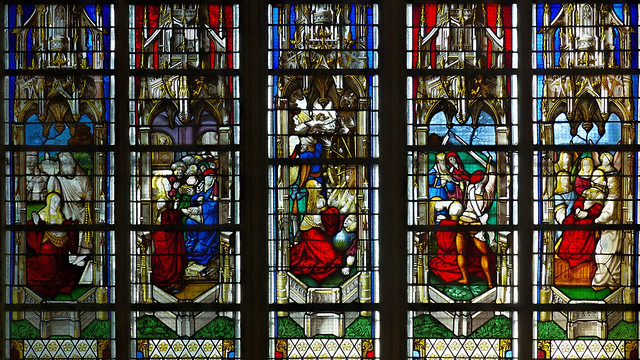The South Aisle Nave Windows — Abbey Church of Saint-Ouen, Rouen
Submitted by walwyn
The south aisle of the nave at Saint-Ouen preserves one of the most varied yet coherent hagiographic ensembles in the church’s glazing programme. Although the windows today comprise mixtures of sixteenth-century fragments, nineteenth-century architectural refitting, and extensive twentieth-century restoration, they collectively articulate a single, sustained theme: the commemoration of exemplary saints whose lives, virtues, and martyrdoms offered models for Christian devotion.
Across this sequence of five-light windows, the viewer encounters a broad spectrum of sanctity. The narratives include missionary bishops such as St Austremoine, holy ancestors represented in the life of Anne and Joachim, and heroic virgin martyrs such as St Agnes and St Catherine. The cycle further extends to clerical martyrs, St Stephen, the protomartyr, and St Vincent of Saragossa, alongside composite assemblages whose iconography preserves fragments of yet other saints’ legends. Though differing in date and origin, these windows function together as a visual procession of witnesses, each saint shown moving through a familiar arc: divine calling, public witness, confrontation with earthly authority, miraculous intervention, and final martyrdom or veneration.
The ensemble owes its complex appearance to its layered history. Many of the narrative fragments originated in the mid-sixteenth century, notably from the former church of Saint-Godard in Rouen, and were re-housed at Saint-Ouen during nineteenth-century reordering campaigns. The 1852 interventions provided the architectural canopies and bases that still structure the windows today. Later restorations, especially those undertaken around 1980 by Joseph Le Chevallier and Durand, completed the iconography with modern landscapes, grisaille borders, and fermaillets, transforming incomplete remnants into unified compositions while preserving recognisable elements of the original painting.
Despite this complex evolution, the south-aisle glazing remains an important testimony to Rouen’s stained-glass tradition. It illustrates not only the skill of Renaissance glass-painters but also the changing philosophies of conservation and historical reconstruction. Above all, the windows continue to fulfil their medieval purpose: to set before the viewer a vibrant gallery of saints whose steadfastness, courage, and faithfulness embody the ideals of Christian life, and to integrate these examples into the liturgical and architectural fabric of Saint-Ouen.
